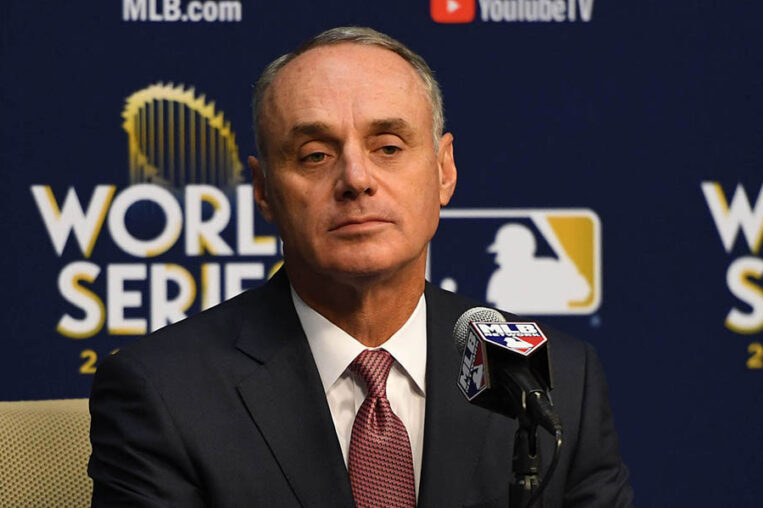
Major League Baseball’s owners and players met Thursday to discuss core economic issues for the first time since December 1. As reported on MMO, the players were “unimpressed” by the proposal put forth by the owners.
It is not realistic to expect a deal in the first negotiation in over a month. It’s likely the owners primary intent in making their offer was to spur further negotiations, including a counterproposal by the players. When that happens, and how the players’ volley is received, will be important factors in whether spring training has a chance to start on time. February 1 is speculated to be the date by which a deal is needed for spring training to start in mid-February as currently planned. A new Collective Bargaining Agreement (CBA) finalized by that date is looking less likely every day.
Jeff Passan of ESPN.com recapped Thursday’s meeting between the players and owners. Let’s look at Passan’s commentary on today’s negotiating session, as it relates to the key issues that have been identified as central to a potential new CBA.
Minimum Salary
Increasing the compensation of young players is a main consideration for the MLBPA in a new CBA. Currently, the minimum salary in MLB is $570, 500, the lowest among the four major sports. The owners did not change their most recent offer on this topic, a raise of the minimum salary to $600,000 for players with one day of service, $650,000 with one year of service, and $700,000 to players with at least two years (arbitration starts for most players at three years of service time).
This is not going to get it done. The increase offered is modest at best, and will not move the needle for pre-arbitration players. It will be interesting to see how the players respond on this parameter. One factor to consider, if the owners want more teams in the postseason, they will increase their revenues significantly. A five percent increase in the minimum salary for one-year players, and a thirteen percent increase for two-year players, seems unrealistic and unfair.
Arbitration
While neither side likes the arbitration process, the players would like to see changes that take salary control out of solely the owners’ hands before three years of service. The owners are adamant that they will not agree to arbitration before three years of service time. In Thursday’s session, the owners put forth a creative proposal. From Passan’s article:
MLB offered a significant revamping of its system in compensating players with between two and three years of major league service time, offering an increase in money going to those players through a formula that would determine their pay.
What does this entail? It’s not 100% clear, but it seems that the owners would give individual players with two years of service time a choice between the current “Super 2” system (those that would qualify-meaning they’re in the top 22% of players with two years’ service), and a new performance-based (details not provided) system to determine their pay. The performance-based system would be the salary process for those who do not qualify for “Super 2.”
Under the arbitration umbrella, the owners offered a way to control manipulation of service time. Currently, teams will keep players in the minor leagues until just after the date when they would get credit for a year of service time. The owners proposed awarding a draft pick if a team places a Top 100 prospect (as evaluated by a combination of reporting outlets) on its opening day roster, then the player wins Rookie of the Year or finishes in the top three of MVP or Cy Young voting within his first three seasons.
Whether this has merit or not depends on how much a team values draft picks. It’s unlikely teams like the Dodgers, Yankees, Red Sox, or Mets (now) would feel an urge to chase an additional draft pick, since their business models can be skewed (more than most) toward free agency as a way to build their rosters. The idea of an additional pick might provide an incentive for teams like the Orioles and Pirates, so perhaps the idea can be a starting point for discussion on addressing service time manipulation.
Competitive Balance Tax
This one will be contentious. The CBT threshold and penalties were not discussed today. The owners said that they just wanted to begin negotiations, and this topic would be discussed later. That’s not really a bad idea, as what both sides are willing to do around the CBT may be influenced by how the other areas come together. To show how far apart they are, the owners have floated increasing the CBT threshold from $210 million to $214 million, while the players have put $245 million on the table. Perhaps if they can agree on other parameters of a deal, they can find some common ground on the CBT, but I think it was wise to keep this topic off today’s docket.
The Draft
Players are concerned that teams “tank” to get prime draft picks, especially teams that rely on building through the draft. This results in less money being spent on the major league product, and less money for the players. The owners tried to address that in Thursday’s session. Passan writes:
The league’s proposal included a tweak to its draft lottery, which it had previously proposed with three teams, to which the union countered asking for eight. MLB stuck with three teams but proposed that a team be ineligible for the lottery in three consecutive seasons, according to sources.
Teams should not be awarded for being non-competitive, particularly repeatedly. The draft lottery needs to happen, along with a disqualification for teams who are in the lottery multiple years in a row. I advocate putting all non-playoff teams in the lottery, with their number of entries weighted based on how they finished the season. A better record equals more chances in the lottery. Why would a team tank? And wouldn’t teams have at least somewhat of an incentive to compete in September? People buy tickets for those games, they’re entitled to see a decent product and an effort to win.
The Playoffs
As noted above, the owners want more teams in the playoffs, as the playoffs are a big revenue stream. On Thursday, they asked for 14 teams in the postseason (up from the current 10). The players are reluctant to agree, thinking that an expanded October field lessens the need to compete, which may reduce spending on players’ salaries.
This one seems obvious to me. More teams in the playoffs is the way sports are going. Baseball can too. Expanding to 14 teams is excessive and should be a non-starter, especially after a 162-game season. Go to the mid-point, and settle on 12 teams in the postseason.
The two best records in each league get a round-one bye. Round one is best-of-three, all games in the home parks of the three and four seeds. After this round is over, the next day is an off day. This adds two days to the postseason schedule, and the teams with byes are idle for four days, not significantly different than the idle time for teams not in wildcard games in the current format. The next two rounds are best-of-seven. In this way, additional playoff games are added for revenue, the season is extended by about one week, and the postseason integrity is not materially compromised.
The owners made a move, and now it’s the players’ turn. The owners moves on key issues were modest, and the players will probably inch a bit closer in their next economic proposal. The problem is that the clock is ticking, and unless the proposals start to represent more significant movement, time will run out for an on-time start to spring training. Next up will be the regular season. If there’s no agreement by March 1 or so, six weeks from now, games could be lost.
MLB and the MLBPA need a sense of urgency. Both sides are trying to use time as an ally, thinking the other side will budge for fear of lost revenue. If they lose fans over this dispute and its potential impact on the 2022 season, the revenue loss will be more significant, and perhaps permanent.















